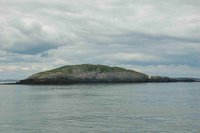
On May 24th we had the privledge to visit Machias Seal Island with a group of 20 students from The Huntsman Marine Science Center. Basically a rock with a lighthouse surrounded by shoals, Machias Seal Island is located 10 miles SW of Grand Manan in the mouth of the Bay of Fundy. What makes Machias Seal Island so special is that it is a nesting site for colonies of Atlantic puffins, razorbills, common murres and Arctic terns. The 3 1/2 hour trip out down Western Passage and out through the Lubec Narrows was calm and surprisingly warm for late May. About 8 miles from our destination we started seeing Atlantic puffins and razorbills.

When we arrived at the island we saw hundreds of razorbills and common murres rafting on the surface of the water and the odd Atlantic Puffin flying by.

These pictures are razorbills, a heavy-headed, short necked alcid that can be identified by it's thick bill (with a white line that extends from the base of the bill to the eye) and long tail which points upward while swimming.
 Alcids are diving birds who use their wings instead of their feet to propel themselves, or fly, under the water in search of food. Other alcids in the Bay of Fundy are Atlantic puffins, common murres, dovekies and black guillemots.
Alcids are diving birds who use their wings instead of their feet to propel themselves, or fly, under the water in search of food. Other alcids in the Bay of Fundy are Atlantic puffins, common murres, dovekies and black guillemots. Ccommon murres also nest on Machias Seal Island. They can be difficult to differentiate from the razorbills at first glance but with their long, thin bills and almost chocolate brown colour with a close look you can see the difference. Common murres also have a thin, white eye ring.
Ccommon murres also nest on Machias Seal Island. They can be difficult to differentiate from the razorbills at first glance but with their long, thin bills and almost chocolate brown colour with a close look you can see the difference. Common murres also have a thin, white eye ring.
The birds on the rocks here are common murres. One of birds that nest on Machias is difficult to photograph unless you land on the Island. The Arctic tern was flying overhead our entire visit, screeching and shrieking, warning us to stay away from their nests. If you are a visitor on the island, they actually give you a stick to hold because the terns will "dive-bomb" your head and try and strike the highest point. If you hold a stick, the stick gets hit with their pointed bill instead of your head. Arctic terns are champion long distance migrants, wintering in Antarctica and nesting as far north as the Arctic, traveling an annual distance of more than 40, 000 km. Terns can easily be identified by their long tail feathers, thin sharply pointed back wings and shrill call.

 On our trip home we spent some time with nesting black-legged kittiwakes and double-crested cormorants on Whitehorse Island.
On our trip home we spent some time with nesting black-legged kittiwakes and double-crested cormorants on Whitehorse Island.
We also stopped at a common seal haul-out site, Splitting Knife, a shoal that's barely visible at high tide, but as the water ebbs becomes an ideal spot for harbour and grey seals to haul out and bathe in the sun.

Machias Seal Island is a rare and special place. It is actually a disputed territory with both Canada and the USA staking claim to the land. Canada has maintained the island for so long that it basically has "Squatters Rights". It also has the only manned lighthouse in the maritimes. You can visit Machias Seal Island through tour companies located on Grand Manan, NB and Machias, ME.
We are looking forward to our whale watching season, it's just around the corner now. We saw quite a few harbour porpoise on our trip to Machias Seal Island which is a good sign. I'll make sure to keep you posted on everything we are seeing as the season continues, so check back often, or better yet, coming whale watching with Quoddy Link Marine...Catamaran Style starting June 24th.
